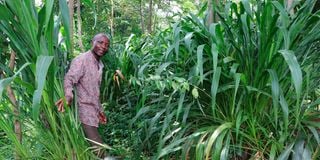Alternative fodder saves the day as disease ravages Napier

Astariko Musundi on his Guatemala grass farm in Indangalasia, Kakamega County.
In Emusala village, Indangalasia micro-catchment area on the periphery of Kakamega forest, the Seeds of Gold team finds Astariko Musundi chopping a mixture of Guatemala, giant setaria and brachiaria grasses into tiny pieces for his three dairy cows.
The grasses are relatively new in Western Kenya where farmers have constantly fed their livestock on Napier grass.
But following the outbreak of the Napier Grass Stunt (NGS) disease more than two decades ago, local farmers are opting for alternative fodder or the newly developed disease-tolerant Napier varieties.
According to Kenya Agricultural and Livestock Research Organisation (Kalro) scientists, NGS is caused by a bacteria known as Phytoplasma.
The disease, which is easily transmitted by the leafhopper, was first observed in Kenya in 1997.
It has since spread to Uganda, Tanzania and Ethiopia, and could soon be found in other countries in the region if measures are not put in place to control it, agronomists warn.
“Before I learnt about these grass varieties from Kalro, I was almost giving up on dairy farming. My entire field under Napier grass had been ravaged by this disease,” Musundi says.
“The situation left me with two options, either to encroach on Kakamega forest and risk arrest and prosecuted for tresspass, or buy fodder from farmers whose lands were not affected by the disease.”
When NGS attacks, it leads to severe stunting and yellowing of the affected plant.
The diseased plants show a profuse growth of shrivelled and unhealthy shoots.
The plant produces thin tillers and remains stunted to less than half a foot even at the time it is expected to be mature.
Often the whole Napier grass stool is affected with complete loss in yield, leading to the eventual death of the plant.
According to Dr Eston Mutitu, an entomologist, leafhoppers feed on young leaves by sucking sap. They then carry the pathogen from one plant to another.
Dr Mutitu says the disease is also spread through infected Napier grass canes and root splits.
Movement of contaminated materials may also spread this deadly disease.
In the early 2000s, many farmers in Kakamega and other parts of Western Kenya were badly affected by this disease, prompting Kalro researchers to embark on a study that would identify alternative grasses which could tolerate the virility of NGS and still perform well in the affected areas.
“We identified different types of fodder from many places. The scientists were also interested in developing grasses that were high-yielding and resistant to the NGS disease,” says Patrick Mudavadi, a senior researcher at the Kalro centre in Alupe, Busia County.
“We needed to have a plant with the ability to grow well in the affected areas. The target plant was also to have nutritional value.”
Mudavadi and his team of researchers started breeding disease-tolerant Napier grasses.
“So far, we have released two varieties called ‘South Africa’ and ‘Ouma, to the farmers. These have shown favourable results,” Mudavadi says.
For Musundi, several grass varieties have proved to be better alternatives than the once-dominant Napier in all aspects.
He and his fellow farmers have begun growing these grasses on a large scale.
Guatemala, for example, is a grass whose origin can be traced to central and South America.
It has been introduced a fodder in many countries around the world.
Farmers and Kalro scientists have established that Guatemala grass does well in the mid to high altitude areas of Western Kenya.
“I like this grass because the leaves remain green and juicy even in dry seasons. That makes Guatemala grass the best alternative to the disease-threatened Napier,” Musundi says.
According to Mudavadi, Guatemala grass is tolerant to NGS and head smut diseases.
“Well-managed Guatemala grass can produce five to seven tonnes of dry matter per acre annually, which is enough for one dairy cow,” Mudavadi says.
Giant setaria as another alternative grass preferred by Musundi and other farmers in Kakamega and neighbouring counties.
It produces 75 per cent of forage produced by the best Napier grass varieties, according to Kalro scientists.
The grass is easily conserved as silage for dry season feeding, and has been found to grow faster than others after harvest.
Apart from Guatemala and giant setaria, farmers in the region are also growing brachiaria.
The species is drought-tolerant, producing between 18 to 20 tonnes per acre.
Some experts and farmers say it is probably the best alternative to Napier grass.
However, Napier grass remains the most important and dominant fodder crop in East African, constituting 40 and 80 per cent of forage in the region.
It is mainly used by smallholder dairy farmers in intensive (zero-grazing) and semi-intensive production systems.





